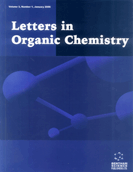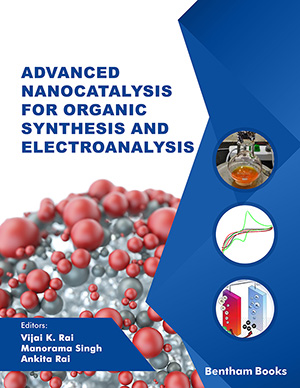
Abstract
Background: Baylis-Hillman reaction requires cheap starting materials, easy reaction protocol, and possibility to create the chiral center in the reaction product has increased the synthetic efficacy of this reaction which also suffers from high catalyst loading, low reaction rate, and poor yield.
Objective: The extensive use of various functional or non-functional ionic liquids (ILs) with organocatalyst acts not only as reaction medium but also as a support to anchor the catalysts to increase the reaction rate of various organic transformations.
Methods: In this manuscript, we have demonstrated the synthesis of quinuclidine-supported trimethylamine-based functionalized ionic liquid as a catalyst for the Baylis-Hillman reaction.
Results: We obtained the Baylis-Hillman adducts in good, isolated yield along with low catalyst loading, short reaction time, wide substrate scope, easy product, and catalyst recycling. N- ((E,3S,4R)-5-benzylidene-tetrahydro-4-hydroxy-6-oxo-2H-pyran-3-yl) palmitamide was also successfully synthesized using CATALYST-3 promoted Baylis-Hillman reaction.
Conclusion: We successfully isolated the 25 types of Baylis-Hillman adducts using three different quinuclidine-supported ammonium-based ionic liquids such as Et3AmQ][BF4] (CATALYST-1), [Et3AmQ][PF6] (CATALYST-2), and [TMAAmEQ][NTf2](CATALYST-3) as new and efficient catalysts. Generally, all the reactions demonstrated higher activity and gave good to high yield in competition with various previously reported homogenous and heterogeneous catalytic systems. Easy catalyst and product recovery followed by 6 times of catalysts recycling were the added advantages of the prosed catalytic system. Tedious and highly active N-((E,3S,4R)-5-benzylidene-tetrahydro- 4-hydroxy-6-oxo-2H-pyran-3-yl) palmitamide derivative was also synthesized using CATALYST- 3 followed by Baylis-Hillman reaction.
Keywords: Organocatalysis, Ionic liquid, baylis-hillman adduct, 3-quinuclidinone, catalyst recycling, supported catalysis.
[http://dx.doi.org/10.1080/00397911.2016.1206938]
[http://dx.doi.org/10.1039/a706415b]
[http://dx.doi.org/10.3762/bjoc.6.6] [PMID: 20485588]
[http://dx.doi.org/10.1039/qr9672100259]
[http://dx.doi.org/10.1021/cr60099a003]
[http://dx.doi.org/10.1155/2013/954094]
[http://dx.doi.org/10.1007/s00706-019-02465-9]
[http://dx.doi.org/10.1007/s10562-016-1943-y]
[http://dx.doi.org/10.1002/chem.202003580] [PMID: 32841442]
[http://dx.doi.org/10.1038/s41570-019-0124-0]
[http://dx.doi.org/10.1039/C8NJ02483A]
[http://dx.doi.org/10.1007/s12039-013-0472-0]
[http://dx.doi.org/10.2174/1385272819666141125003114]
[http://dx.doi.org/10.3390/molecules15020709] [PMID: 20335941]
[http://dx.doi.org/10.1039/B309117A] [PMID: 14651114]
[http://dx.doi.org/10.1002/adsc.200303072]
[http://dx.doi.org/10.1002/ejoc.201001507]
[http://dx.doi.org/10.1039/B915577E] [PMID: 20198268]
[http://dx.doi.org/10.1021/ja0717865] [PMID: 18041831]
[http://dx.doi.org/10.1021/acs.oprd.8b00298]
[http://dx.doi.org/10.1021/ja410781z] [PMID: 24354494]
[http://dx.doi.org/10.1002/adsc.201600421]
[http://dx.doi.org/10.1007/BF02697140]
[http://dx.doi.org/10.1016/j.molcata.2003.10.002]
[http://dx.doi.org/10.1021/jo301348k] [PMID: 22931044]
[http://dx.doi.org/10.1039/C8RA02409J]
[http://dx.doi.org/10.1039/b203079a] [PMID: 12170807]
[http://dx.doi.org/10.1021/jo048391d] [PMID: 15760226]
[http://dx.doi.org/10.1515/chem-2018-0065]
[http://dx.doi.org/10.1007/s10562-017-1995-7]
[http://dx.doi.org/10.1021/ja017593d] [PMID: 11829599]
[http://dx.doi.org/10.3184/174751912X13374255642515]
[http://dx.doi.org/10.1021/ja00865a036]
[http://dx.doi.org/10.1155/2012/248135] [PMID: 22400113]
[http://dx.doi.org/10.1021/cr0100446] [PMID: 16771445]
[http://dx.doi.org/10.1042/BJ20111626] [PMID: 22248339]
[http://dx.doi.org/10.1002/anie.200501983] [PMID: 16365835]
[http://dx.doi.org/10.1021/jo026242u] [PMID: 12530860]
 34
34 1
1

























